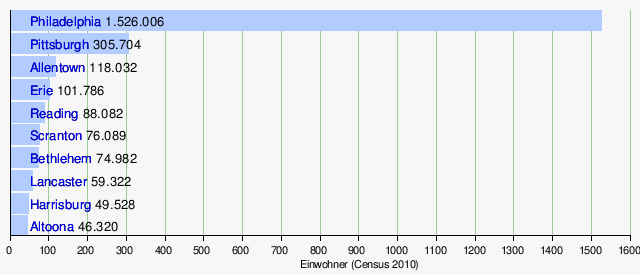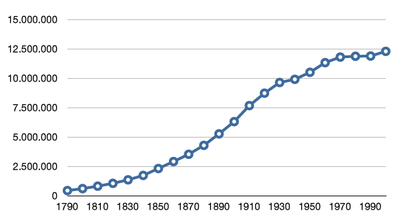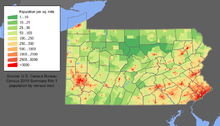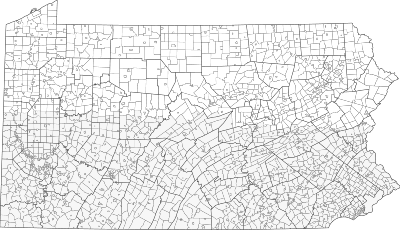Pennsylvania
![]()
This article is about the U.S. state. For other meanings, see Pennsylvania (disambiguation).
Pennsylvania (English pronunciation [![]()
![]() ˌpɛnsɪlˈveɪ̯nɪə̯]) is a state founded by William Penn in the eastern United States of America and one of its thirteen founding states. Its official name is Commonwealth of Pennsylvania ("Commonwealth of Pennsylvania"). Together with New York and New Jersey, Pennsylvania is classified as a Mid-Atlantic state.
ˌpɛnsɪlˈveɪ̯nɪə̯]) is a state founded by William Penn in the eastern United States of America and one of its thirteen founding states. Its official name is Commonwealth of Pennsylvania ("Commonwealth of Pennsylvania"). Together with New York and New Jersey, Pennsylvania is classified as a Mid-Atlantic state.
The name literally means "woodland of Penn" (from Latin silva "forest"). Pennsylvania is nicknamed the Keystone State, after the central wedge-shaped stone in the middle of an arch).
Geography
Location
Pennsylvania is bordered by New Jersey to the east, Delaware to the southeast, Maryland to the south, West Virginia to the southwest, Ohio to the west, Lake Erie to the northwest, and New York State to the north. The extension is 274 km in north-south direction and 455 km in east-west direction.
The total area of the state is 119,283 km², making it slightly larger than Bulgaria. Of this, 116,075 km² are land areas; 3,208 km² are water surfaces, of which Lake Erie accounts for 1,940 km².
The state's highest elevation, at 979 feet above sea level, is Mount Davis, named for its owner, a schoolteacher who fought on the Union side at the Battle of Gettysburg. The lowest point in Pennsylvania is at sea level on the Delaware River. The average elevation is 336 m.
The main river running through the state is called the Susquehanna River. Pennsylvania is characterized by deciduous forests and hilly country. In the east of the country you can find the low mountain range of the Appalachians.
In the south of the state lies the archaeologically interesting excavation site of Meadowcroft.
Structure
- List of counties in Pennsylvania

Pinchot State Forest
Population
Pennsylvania has a population of 12,702,379 (as of the 2010 U.S. Census), of which 79.5% are white, 10.8% African American, 5.7% Hispanic, 2.7% Asian, 0.2% Native American.
Age and gender structure
The age distribution of Pennsylvania is as follows:
- up to 18 years: 2,807,534 (22.6 %)
- 18-64 years: 7,749,853 (62.3 %)
- 65 years and older: 1,883,231 (15.1 %)
The median age is 39.6 years. 48.6% of the population is male and 51.4% is female.
Ancestry
3,239,286 Pennsylvania residents reported having ethnic German ancestors in the 2014 American Community Survey. With a share of 25.3% of the total population, ethnic Germans are the largest population group in the state. They are followed by a wide margin by groups of Irish (16.4%), Italian (12.2%), English (7.0%), and Polish (6.4%) descent.
German-speaking immigrants, the Pennsylvania Dutch, among them Mennonites and Amish, settled mainly in the South, especially in Lancaster County. Germantown was founded in 1683. Berks County was settled mostly by Protestant Germans in the 18th century. 30,000 immigrants from 1727 to 1776 are published by name with details of names of ships, place of embarkation, and date of arrival in Philadelphia.
Population development
| Population development | |||
| Census | Inhabitants | ± in % | |
| 1790 | 434.373 | - — | |
| 1800 | 602.365 | 38,7 % | |
| 1810 | 810.091 | 34,5 % | |
| 1820 | 1.049.458 | 29,5 % | |
| 1830 | 1.348.233 | 28,5 % | |
| 1840 | 1.724.033 | 27,9 % | |
| 1850 | 2.311.786 | 34,1 % | |
| 1860 | 2.906.215 | 25,7 % | |
| 1870 | 3.521.951 | 21,2 % | |
| 1880 | 4.282.891 | 21,6 % | |
| 1890 | 5.258.113 | 22,8 % | |
| 1900 | 6.302.115 | 19,9 % | |
| 1910 | 7.665.111 | 21,6 % | |
| 1920 | 8.720.017 | 13,8 % | |
| 1930 | 9.631.350 | 10,5 % | |
| 1940 | 9.900.180 | 2,8 % | |
| 1950 | 10.498.012 | 6 % | |
| 1960 | 11.319.366 | 7,8 % | |
| 1970 | 11.793.909 | 4,2 % | |
| 1980 | 11.863.895 | 0,6 % | |
| 1990 | 11.881.643 | 0,1 % | |
| 2000 | 12.281.054 | 3,4 % | |
| 2010 | 12.702.379 | 3,4 % | |
| Before 1900 1900–1990 2000 | |||
Religions
The largest religious denominations in 2000 were the Catholic Church with 3,802,524, the United Methodist Church with 659,350, and the Evangelical Lutheran Church in America with 611,913 adherents. Philadelphia is home to the North American headquarters of the Medical Mission Sisters (MMS).
Languages
Pennsylvania has no official language. However, the English language and partly also the German language are mainly used by official bodies.
Largest cities

See also: List of places in Pennsylvania

Population development of Pennsylvania

Population density

The map shows the municipal division of Pennsylvania
Questions and Answers
Q: What is the state capital of Pennsylvania?
A: The state capital of Pennsylvania is Harrisburg.
Q: What is the largest city in Pennsylvania?
A: The largest city in Pennsylvania is Philadelphia.
Q: What is the nickname for Pennsylvania?
A: The nickname for Pennsylvania is "The Keystone State".
Q: Who is the current governor of Pennsylvania?
A: The current governor of Pennsylvania is Tom Wolf.
Q: What role did Pennsylvania play in American history?
A: Pennsylvania played an important role in the American Revolution.
Q: Are there any unique communities located in PA? A: Yes, there are large communities of Amish located in PA.
Q: What type of industry does PA have a reputation for? A: PA has a reputation for its heavy industry.
Search within the encyclopedia